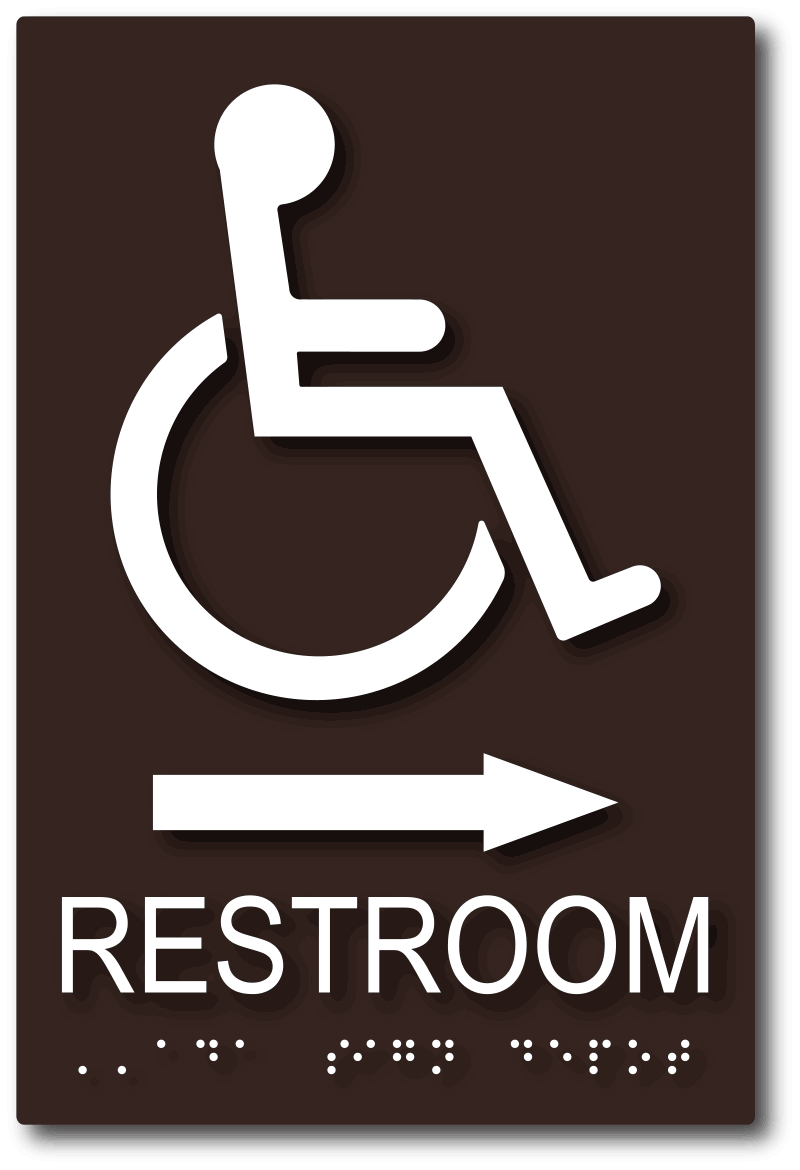Checking Out Imaginative Styles for Effective ADA Signs
Discovering the Key Features of ADA Indications for Enhanced Accessibility
In the world of access, ADA indicators function as quiet yet effective allies, making certain that rooms are navigable and comprehensive for people with handicaps. By incorporating Braille and responsive aspects, these indications damage barriers for the aesthetically damaged, while high-contrast color design and legible fonts deal with diverse visual demands. Additionally, their tactical positioning is not approximate yet instead a calculated initiative to facilitate seamless navigation. Yet, beyond these attributes lies a much deeper narrative concerning the advancement of inclusivity and the ongoing dedication to developing equitable rooms. What much more could these indicators symbolize in our search of universal accessibility?
Significance of ADA Conformity
Making certain compliance with the Americans with Disabilities Act (ADA) is crucial for promoting inclusivity and equivalent accessibility in public spaces and work environments. The ADA, passed in 1990, mandates that all public centers, employers, and transportation solutions suit people with impairments, ensuring they take pleasure in the very same rights and chances as others. Conformity with ADA criteria not just fulfills legal responsibilities yet additionally enhances an organization's credibility by showing its commitment to diversity and inclusivity.
One of the key facets of ADA conformity is the application of available signage. ADA indicators are created to make sure that individuals with impairments can easily navigate with buildings and spaces.
Additionally, sticking to ADA guidelines can reduce the risk of lawful consequences and prospective fines. Organizations that fail to follow ADA guidelines might deal with penalties or legal actions, which can be both destructive and economically burdensome to their public picture. Thus, ADA conformity is integral to cultivating an equitable atmosphere for every person.
Braille and Tactile Components
The unification of Braille and tactile elements into ADA signage symbolizes the concepts of accessibility and inclusivity. It is generally put underneath the equivalent message on signs to ensure that individuals can access the information without visual assistance.
Responsive components expand past Braille and consist of elevated personalities and icons. These parts are made to be noticeable by touch, permitting people to recognize area numbers, toilets, exits, and other critical areas. The ADA establishes details standards pertaining to the size, spacing, and positioning of these responsive aspects to optimize readability and ensure uniformity throughout different settings.

High-Contrast Color Design
High-contrast color systems play an essential function in enhancing the presence and readability of ADA signage for individuals with aesthetic problems. These systems are essential as they take full advantage of the difference in light reflectance in between text and background, making certain that signs are conveniently noticeable, even from a range. The Americans with Disabilities Act (ADA) mandates making use of details color contrasts to suit those with restricted vision, making it a crucial facet of compliance.
The efficiency of high-contrast colors exists in their ability to stick out click here for info in numerous illumination problems, including poorly lit environments and areas with glare. Commonly, dark message on a light history or light text on a dark background is used to achieve ideal comparison. Black message on a yellow or white background supplies a raw aesthetic difference that helps in fast acknowledgment and understanding.

Legible Fonts and Text Dimension
When considering the design of ADA signs, the selection of readable font styles and proper text size can not be overemphasized. The Americans with Disabilities Act (ADA) mandates that typefaces need to be sans-serif and not italic, oblique, script, highly attractive, or of uncommon form.
According to ADA guidelines, the minimal message height should be 5/8 inch, and it needs to boost proportionally with seeing range. Uniformity in text dimension contributes to a cohesive aesthetic experience, assisting individuals in browsing atmospheres successfully.
Moreover, spacing between lines you can try this out and letters is essential to readability. Sufficient spacing prevents personalities from appearing crowded, improving readability. By sticking to these requirements, developers can substantially improve availability, ensuring that signs offers its intended function for all people, no matter their aesthetic capabilities.
Efficient Positioning Strategies
Strategic positioning of ADA signs is necessary for making the most of ease of access and guaranteeing compliance with lawful criteria. ADA standards state that indications should be placed at an elevation in between 48 to 60 inches from the ground to ensure they are within the line of sight for both standing and seated individuals.
Furthermore, indicators should be positioned nearby to the latch side of doors to enable easy recognition before entrance. Consistency in indicator placement throughout a center enhances predictability, minimizing confusion and enhancing overall individual experience.

Conclusion
ADA indicators play a vital duty in advertising accessibility by incorporating attributes that resolve the demands of people with specials needs. These aspects collectively foster an inclusive environment, emphasizing the importance of ADA compliance in making certain equivalent gain access to for all.
In the realm of ease of access, ADA signs offer as quiet yet powerful allies, ensuring that rooms are inclusive and accessible for people with impairments. The ADA, enacted in 1990, mandates that all public centers, employers, and transportation solutions fit individuals with handicaps, guaranteeing they delight in the same civil liberties and chances as others. ADA Signs. ADA signs are made to make sure that individuals with handicaps can quickly navigate via areas and buildings. ADA standards state that indicators read this post here must be mounted at an elevation between 48 to 60 inches from the ground to guarantee they are within the line of sight for both standing and seated people.ADA indications play a vital duty in promoting access by integrating features that resolve the requirements of people with specials needs